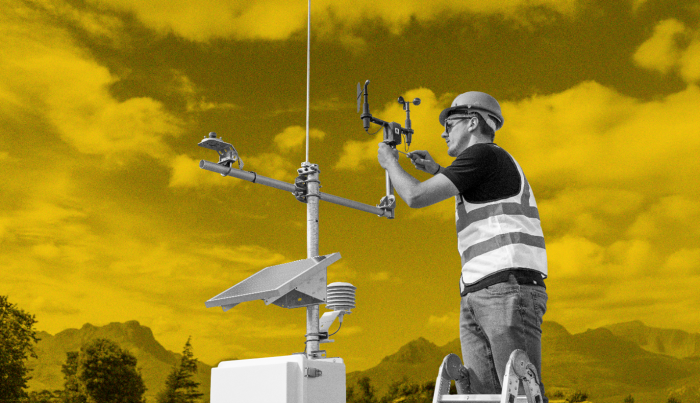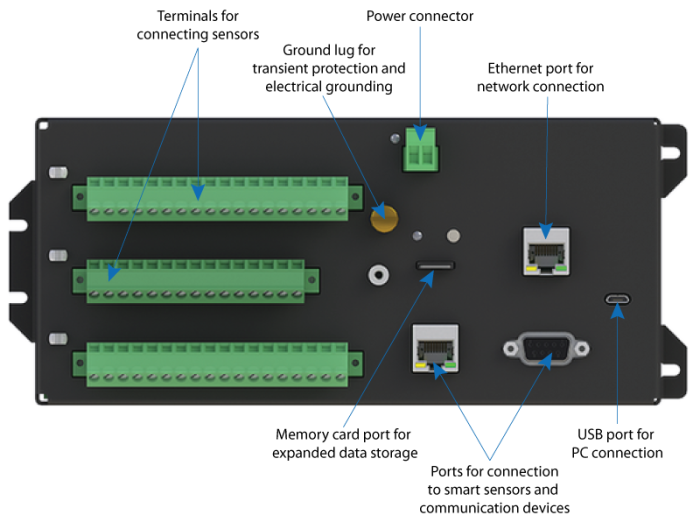A Beginner's Guide to Automated Weather Stations (AWS)
by Aspen Nielsen | 更新日: 11/10/2025 | コメント: 0

When weather impacts decisions, safety, livelihoods, and research, there is no room for guesswork. The modern world depends on data, including accurate weather information. While “data-driven decisions” is often treated like a buzzword, in the field it means the difference between reacting with uncertainty and being confidently prepared.
That’s where automated weather stations (AWS) come in. These robust systems are built to operate continuously and largely independently in challenging environments, collecting precise weather data without the need for constant supervision.
In this article, I’ll highlight what components compose an AWS, why they’re important, and some of the key instrumentation functionalities—from data loggers to sensors to software. Whether you’re just exploring or ready to deploy, this guide is your starting point for making weather measurements work for you.
What is an automated weather station?
An AWS is a system designed to continuously monitor and record environmental conditions, such as soil, surface water, or atmospheric data, with precision and minimal human intervention. Equipped with a variety of sensors, an AWS delivers accurate, real‑time data that support informed decision-making in a variety of applications including agriculture, road weather, environmental research, severe weather monitoring, and aviation.
By automating both data collection and transmission, AWS solutions offer dependable, around-the-clock insights that help users respond proactively to changing conditions.
Most AWS setups include several key components, such as:
- Sensors – From air temperature and flux to precipitation and visibility, Campbell Scientific offers a wide variety of rugged and dependable sensors for environmental, infrastructure, and renewable energy applications.
- Data Loggers – The data logger is the “brain” of the entire AWS setup and is responsible for collecting the measurements from the sensors. Some data loggers offer built-in communications options, such as cellular, Wi-Fi, or Ethernet connectivity.
- Power Supplies – Power is essential to continuously operate your weather station. Power requirements vary greatly depending on sensor choice, AWS siting and location, and other factors. If you’re uncertain about how much power you’ll need, consult your sales engineer for a power budget.
- Protecting your instrumentation from excessive power comes in many forms. Whether you use surge protection, lightning arrestors, charge regulators, or a combination of all three, a proactive approach to protecting your instrumentation is generally recommended.
- Some solutions call for a combination of solar panels and batteries, while other installations require wired power. Your sales engineer can help you determine what may be best depending on your unique measurement needs.
- Communications/Telemetry Equipment – Whether you’re manually collecting the data from your data logger or communicating over cellular, Ethernet, radio, Wi-Fi, or even satellite, considering how you want to receive your data is an important AWS design factor.
- Mounting Equipment and Enclosures – Choosing the appropriate tripod, tower, crossarms, and enclosures helps ensure that your instrumentation will be stable and protected. Correct mounting procedures can also be a crucial part of ensuring accurate measurements.
- Software – You use software for data logger programming, data management, and visualization to provide actionable insights. With a host of software options from CampbellCloud™ to LoggerNet and even application-specific software options, Campbell Scientific has software that can help.
Key Measurements and Their Importance
While many types of sensors can be added to a monitoring station based on your specific needs, this section focuses on some of those most used in environmental monitoring.
- Air Temperature Sensors – Often considered a core component of an AWS, accurate air temperature measurements support many other sensor readings. Use of a compatible solar radiation shield is recommended with all Campbell Scientific air temperature sensors.
Recommended for You: Need to meet World Meteorological Organization (WMO) temperature specs? Check out The 0.1°C Challenge: The Heat on Temperature Sensors that Meet WMO Recommendations for a detailed guide on why WMO guidelines matter, and how to meet or even exceed them!
- Air Temperature and Relative Humidity (RH) Sensors – These sensors offer space and cost efficiency by combining two measurements in one device. We advise using a compatible solar radiation shield with these sensors.
- Barometric Pressure Sensors – These sensors measure atmospheric pressure with high precision, helping detect changes relevant to weather forecasting, safety, and environmental monitoring. Barometric pressure sensors should be installed inside a vented enclosure to prevent damage.
- Precipitation Sensors – Available in various designs, most measure liquid precipitation (rain), while heated models can also detect solid forms (such as snow).
- Soil Moisture Sensors – These sensors determine the volumetric water content (VWC) of soil, and some also provide soil temperature and electrical conductivity readings. Installation requirements may vary; hard or rocky soils may require specialized tools such as augers or installation rods.
- Solar Radiation Sensors – There is a wide range of available solar radiation sensors, each with different spectral ranges and ISO classifications. Consider using a mounting stand with solar radiation sensors.
- Wind Sensors – These are used to measure wind speed, direction, or both. When selecting wind sensors, consider the environmental conditions and measurement accuracy needed.
Sensor compatibility with your existing AWS or data logger may vary, so it’s a good idea to check with your sales engineer. They can help confirm what works and talk through any other details you might need to consider.
Data Loggers: The Intelligence behind AWS
At the heart of any AWS or data-acquisition system is the data logger, the critical component that makes the entire system functional to continuously collect, process, and manage data from connected sensors.
After collecting measurements at programmed intervals, the data logger stores the information locally or sends it to a data management system using wired or wireless communications channels. This enables real-time monitoring, long-term trend analysis, and automated alerts to support decisions in application fields, including agriculture, meteorology, hydrology, and environmental monitoring.
Today’s data loggers are highly flexible and programmable. They can be customized to handle complex tasks, such as triggering alerts based on specific conditions. This adaptability makes them a great fit for everything from rugged outdoor environments to controlled industrial sites.

When you select a data logger, it can be helpful to consider the following factors to find the right fit for your application:
- Inputs – Determines how many sensors the data logger can support and what types (analog, digital, etc.)
- Scan Rate – Defines how quickly and frequently the data logger can sample data
- Operating Temperature Range – Specifies the temperature limits within which the data logger can operate reliably, which is important for outdoor and extreme conditions
- Communications Ports – Includes native ports (for example: RS-232, RS-485, SDI-12, CS I/O, USB, Ethernet) to help you plan how data will be retrieved or transmitted
- Integrated Communications/Charge Regulators – Some units come with built-in cellular or radio modems, as well as charge regulators for power regulation, which reduce the need for additional hardware and save enclosure space.
- Power Requirements – Indicates the voltage needed to sustain the data logger
- Data Logger Storage Capacities – Because internal memory varies between models, some data loggers support external memory for periodic data offloading to prevent loss.
- Flexibility and Future-Proofing – Future-proofed data loggers often support data ingestion from multiple sensor vendors, have the option to use different communications protocols, etc.
- Other Factors – Depending on your unique application, other factors may be critical to find and select the best data logger for your needs.
Choosing the right data logger allows your system to capture accurate, reliable data; communicate effectively; and perform consistently under the specific demands of your application and environment.
Software and Data Management Applications
Collecting meteorological data requires more than just installing a weather station and walking away. During installation, software is used to program your data logger so it can gather data from your sensors at set intervals and transmit that data through your communications hardware, depending on your needs.
But software does more than just handle programming. It’s essential for visualizing data, setting up alerts, and managing your system. From server-based tools such as LoggerNet to cloud-based platforms like CampbellCloud, the software you choose plays a key role in your weather station’s long-term success. Campbell Scientific has a comprehensive software suite. Chat with your sales engineer to choose the right software solution for your needs.
From Installation to Recalibration: Services to Support Your Station
If you’re looking for expert installation or help programming your data logger, we offer a wide range of services, for an additional fee, to help you correctly set up your weather station. We also provide ongoing support. As your station ages, recalibration and repair services are available for select sensors and data loggers to keep your system performing at its best.
Decades of Expertise, at Your Service
Whether you’re designing your first or hundredth weather station, it can feel daunting or overwhelming. Since 1974, Campbell Scientific has been a trusted leader in the environmental monitoring industry, and we are here to help!
In personalized (and complimentary) consultations, we will provide expert guidance for all this and more. With offices around the globe, you’ll get region-specific support as you build your weather station to capture reliable, dependable data.
Start building your AWS with confidence. Contact our sales engineering team today for free expert consultation and practical tips to make building your station simple and successful.
Credits: Dan Russell of Campbell Scientific, Inc. contributed to this article.
















 Aspen Nielsen is a marketing specialist at Campbell Scientific, Inc., where she focuses on creating customer-centered campaigns, delivering meaningful content through data-driven analytics, and supporting cross-functional teams. She joined the company in 2022 and stepped into her current role in 2025 after earning her MBA from Western Governors University. When she’s not working, Aspen enjoys hiking in the mountains, painting landscapes, reading novels, and spending time with her beloved cat, Nova.
Aspen Nielsen is a marketing specialist at Campbell Scientific, Inc., where she focuses on creating customer-centered campaigns, delivering meaningful content through data-driven analytics, and supporting cross-functional teams. She joined the company in 2022 and stepped into her current role in 2025 after earning her MBA from Western Governors University. When she’s not working, Aspen enjoys hiking in the mountains, painting landscapes, reading novels, and spending time with her beloved cat, Nova.
コメント
Please log in or register to comment.